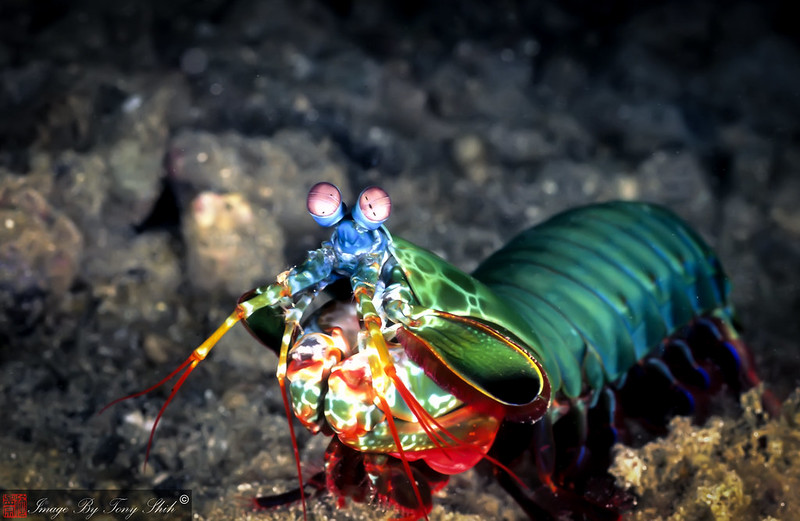
Sea Wonder: Peacock Mantis Shrimp

Photo credit: Tony Shih
Don’t let their small size and vibrant beauty fool you. The peacock mantis shrimp (Odontactylus scyllarus) can pack quite the punch!
Description
Peacock mantis shrimp are crustaceans, part of the same group of hard-shelled animals that includes crabs, lobsters, and shrimps. There are many species of mantis shrimp in the global ocean, and the peacock mantis is one of the largest, clocking in at lengths of two to seven inches when fully grown. Their bodies are bursting with bright colors like red, orange, green, and blue, with some spots on their forearms. Interestingly, females are mostly red while males have more variation in their coloration. This species also holds the world record for the most complex visual system, able to sense many forms of light and color. Their eyes are similar to crabs, bees, and butterflies in that they have compound eyes comprised of thousands of individual receptors that form the eye. Peacock mantis shrimp have receptors that help them see UV light, visible and polarized light, and are the only animals known to detect circularly polarized light, which is a unique form of light wave. This means that peacock mantis shrimp truly see the world in full color, able to see wavelengths that we can hardly even imagine!
Diet and Habitat
Peacock mantis shrimp live in the warm waters of the Indian and Pacific Oceans. Their preferred habitats include coral reefs and sand flats at depths of up to 130 feet. These shrimps are feisty and able to kill prey many times larger than themselves using their raptorial appendages – club-like arms they fold underneath their bodies that look like the front legs of a praying mantis – to produce a pulverizing punch faster than the blink of an eye. Their record-breaking punches have the same acceleration as a .22 caliber bullet, can superheat the water around it, and is one of the strongest pound-for-pound punches on planet Earth! Because their clubs can produce and withstand such incredible force, researchers believe that understanding these biological structures can help with the creation of stronger body armor, protective sports gear, and aerospace equipment.
Peacock mantis shrimp are diurnal, opportunistic feeders, which is a fancy scientific way of saying they will eat any time of the day and are not very picky. Their usual diet consists of gastropods, crabs, and mollusks, and sometimes even other peacock mantis shrimp. To hunt, these shrimps often dig themselves into shallow, u-shaped burrows and remain almost completely still until an unsuspecting victim passes by. They unleash their powerful punches before their prey even realize what has happened, and the peacock mantis shrimp will approach it to feed on its tissue.
Life History
Peacock mantis shrimp start their lives as tiny larvae that move with the currents until they grow to be large enough to control their own motion. As they reach their juvenile life stage, they begin forming their shells, which they shed as they grow into adulthood. Their typical lifespan is between three and six years, though some individuals have lived to be twenty!
Since they live in warm, food-rich waters, peacock mantis shrimp can reproduce several times each year, the timing of which depends on environmental conditions. Male peacock mantis shrimp are known to perform elaborate courtship dances for females and are aggressive toward other males. In both instances, they orient their bodies to show off the brightness and reflectivity of their colored patches. If a female accepts a male’s elaborate display, they reproduce via internal fertilization. This species is an oviparous, or egg-laying species, and females will carry thousands of fertilized eggs around on the front of her body, protecting and cleaning them until they hatch. Once the larvae hatch, they are on their own without any parental investment. Some peacock mantis shrimp form monogamous pair bonds.
Threats and Conservation
The peacock mantis shrimp is not threatened or endangered, though scientists do lack long-term data that would help them see any population trends. As coral residents, the species is vulnerable to anthropogenic impacts that put reef ecosystems at risk. These include coastal development, overfishing, and ocean warming and acidification. The peacock mantis shrimp is also directly exploited as a food source in some countries and as a desirable species for the private aquarium industry.

Photo credit: Aziz Saltik
